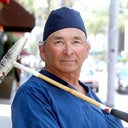Thank you for your question. You’re asking in line with a previous question about the timing of otoplasty with facelift where there is a consensus of both procedures can be done at the same time. However, in your situation, you’re going to have otoplasty first. You want to know what is the ideal timeframe between having the otoplasty and the facelift. You also describe your procedure for otoplasty is going to be a mixture of cartilage removal and sutures.





